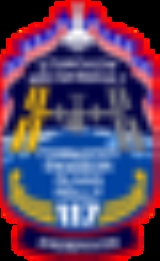
STS-118
Encyclopedia
Crew notes
Astronaut Clayton AndersonClayton Anderson
Clayton Conrad Anderson is an American engineer and a NASA astronaut. Launched on STS-117, he replaced Sunita Williams on June 10, 2007 as a member of the ISS Expedition 15 crew.-Education:...
originally was slated to be launched to the ISS on this mission, but was moved to STS-117
STS-117
- Crew Notes :The initial crew manifest before the Columbia accident was:Astronaut Mark Polansky was originally slated to pilot this mission, but was moved to STS-116, which he commanded...
. His replacement was Alvin Drew.
NASA press releases and media briefing documents stated that STS-118 was the first flight of an Mission Specialist Educator
Educator Astronaut Project
The Educator Astronaut Project is a NASA program designed to educate students and spur excitement in math, science, and space exploration. It is a successor to the Teacher in Space Project of the 1980s that was cancelled after Christa McAuliffe died in the Space Shuttle Challenger disaster...
due to the presence of Barbara Morgan
Barbara Morgan
Barbara Radding Morgan is an American teacher and a former NASA astronaut. She participated in the Teacher in Space program as the backup to Christa McAuliffe for the ill-fated STS-51L mission of Space Shuttle Challenger. She then trained as a Mission Specialist, and flew on STS-118 in August 2007...
. The Educator Astronaut Project is the successor to NASA
NASA
The National Aeronautics and Space Administration is the agency of the United States government that is responsible for the nation's civilian space program and for aeronautics and aerospace research...
's Teacher in Space Project
Teacher in Space Project
The Teacher in Space Project was a NASA program announced by Ronald Reagan in 1984 designed to inspire students, honor teachers, and spur interest in mathematics, science, and space exploration....
, which ended with the Space Shuttle Challenger disaster
Space Shuttle Challenger disaster
The Space Shuttle Challenger disaster occurred on January 28, 1986, when Space Shuttle Challenger broke apart 73 seconds into its flight, leading to the deaths of its seven crew members. The spacecraft disintegrated over the Atlantic Ocean, off the coast of central Florida at 11:38 am EST...
in 1986. Also, the official STS-118 mission patch included a flame of knowledge that represented the importance of education, and honored teachers and students everywhere. The tip of the flames touched Morgan's name on the patch. However, NASA Administrator Michael D. Griffin
Michael D. Griffin
Michael Douglas Griffin is an American physicist and aerospace engineer. From April 13, 2005 to January 20, 2009 he served as Administrator of NASA, the space agency of the United States...
clarified at a post-mission press conference that Morgan was not considered a Mission Specialist Educator, but rather a standard Mission Specialist, who had once been a teacher.
Prior to the Columbia disaster, the crew manifest for STS-118 was:
Mission parameters
- MassMassMass can be defined as a quantitive measure of the resistance an object has to change in its velocity.In physics, mass commonly refers to any of the following three properties of matter, which have been shown experimentally to be equivalent:...
:- Orbiter liftoff: 268574 pounds (121,823.1 kg)
- Orbiter landing: 222398 pounds (100,878 kg)
- PerigeePerigeePerigee is the point at which an object makes its closest approach to the Earth.. Often the term is used in a broader sense to define the point in an orbit where the orbiting body is closest to the body it orbits. The opposite is the apogee, the farthest or highest point.The Greek prefix "peri"...
: 226 kilometres (140.4 mi) - Apogee: 226 kilometres (140.4 mi)
- InclinationInclinationInclination in general is the angle between a reference plane and another plane or axis of direction.-Orbits:The inclination is one of the six orbital parameters describing the shape and orientation of a celestial orbit...
: 51.6° - PeriodOrbital periodThe orbital period is the time taken for a given object to make one complete orbit about another object.When mentioned without further qualification in astronomy this refers to the sidereal period of an astronomical object, which is calculated with respect to the stars.There are several kinds of...
: 91.6 minutes
Mission payloads
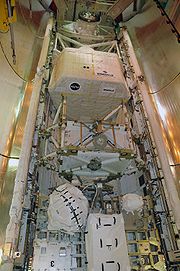
External Stowage Platform
External Stowage Platforms are key components of the International Space Station . Each ESP is an external pallet that can hold spare parts, also known as Orbital Replacement Units , for the space station. As a platform it is not pressurized, but does require electricity to power the heaters of...
, (ESP-3) and a replacement Control Moment Gyroscope
Control moment gyroscope
A control momentum gyroscope is an attitude control device generally used in spacecraft attitude control systems. A CMG consists of a spinning rotor and one or more motorized gimbals that tilt the rotor’s angular momentum. As the rotor tilts, the changing angular momentum causes a gyroscopic...
(CMG). The mission was also the final flight to include the Spacehab
SPACEHAB
Astrotech Corporation , formerly Spacehab Inc., is an aerospace company headquartered in Austin, Texas which provides commercial space products and services to NASA, the U.S. Department of Defense, international space agencies, and global commercial customers...
Logistics Single Module.
The Spacehab Logistics Single Module, a pressurized aluminum habitat that is carried inside the payload bay, has a capacity of 6000 pounds (2,721.6 kg), and carried a variety of cargo and research projects, including supply materials for the ISS. It returned cargo, including the MISSE PEC 3 & 4, a Department of Defense
United States Department of Defense
The United States Department of Defense is the U.S...
payload that had been installed on the ISS. Launched in July 2006, the MISSE PEC-3 & 4
Materials International Space Station Experiment
The Materials International Space Station Experiment , is a series of experiments mounted externally on the International Space Station that investigates the effects of long-term exposure of materials to the harsh space environment....
contained over 850 materials specimens that will be studied to determine the effects of long-term exposure to the environment of space.
| Location | Cargo | Mass |
|---|---|---|
| Bay 1–2 | Orbiter Docking System EMU Extravehicular Mobility Unit The Space Shuttle/International Space Station Extravehicular Mobility Unit is an independent anthropomorphic system that provides environmental protection, mobility, life support, and communications for a Space Shuttle or International Space Station crew member to perform extra-vehicular activity... 3010 / EMU 3017 |
1800 kilograms (3,968.3 lb)? |
| Bay 3 | Tunnel Adapter | 112 kilograms (246.9 lb) |
| Bay 5–7 | Spacehab-SM | 5480 kilograms (12,081.3 lb)? |
| Bay 8P | Shuttle Power Distribution Unit (SPDU) |
?0 kilogram (0 lb) |
| Bay 8–10 | Truss Segment S5 | 1584 kilograms (3,492.1 lb) |
| Bay 11–12 | ESP-3 External Stowage Platform External Stowage Platforms are key components of the International Space Station . Each ESP is an external pallet that can hold spare parts, also known as Orbital Replacement Units , for the space station. As a platform it is not pressurized, but does require electricity to power the heaters of... |
3400 kilograms (7,495.7 lb) |
| Sill | OBSS Orbiter Boom Sensor System The Orbiter Boom Sensor System is a 50-foot boom carried on board NASA's Space Shuttles. The boom can be grappled by the Canadarm and serves as an extension of the arm, doubling its length to a combined total of 100 feet... |
450 kilograms (992.1 lb)? |
| Sill | RMS 201 | 390 kilograms (859.8 lb) |
| Total: | 14036 kilograms (30,944.1 lb) |
Mission background
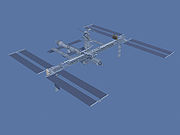
Space Shuttle Columbia disaster
The Space Shuttle Columbia disaster occurred on February 1, 2003, when shortly before it was scheduled to conclude its 28th mission, STS-107, the Space Shuttle Columbia disintegrated over Texas and Louisiana during re-entry into the Earth's atmosphere, resulting in the death of all seven crew members...
altered the planned flight schedules, and the mission was rescheduled for Endeavour. STS-118 served as Endeavours return to flight after a planned orbiter re-fit and maintenance period that resulted in over 200 modifications to the orbiter.
One of the most important modifications that debuted during STS-118 is an upgraded power-distribution module, the Station-Shuttle Power Transfer System
Electrical system of the International Space Station
The electrical system of the International Space Station is a critical resource for the International Space Station because it allows the crew to live comfortably, to safely operate the station, and to perform scientific experiments. The ISS electrical system uses solar cells to directly convert...
(SSPTS). SSPTS allows Endeavour to tap into the ISS power supply, converting up to eight kilowatts of electrical power from 120-volts direct-current (120VDC) ISS main voltage to the 28VDC system used by the orbiter. SSPTS was outfitted to the ISS Pressurized Mating Adapter
Pressurized Mating Adapter
The International Space Station uses three Pressurized Mating Adapters to interconnect spacecraft and modules with different docking mechanisms. The first two PMAs were launched with the Unity module in 1998 aboard STS-88...
-2 (PMA2) during STS-116
STS-116
-Crew notes:Originally this mission was to carry the Expedition 8 crew to the ISS. The original crew was to be:-Mission highlights:* The STS-116 mission delivered and attached the International Space Station's third port truss segment, the P5 truss....
. These upgrades will allow orbiters to remain docked at the station for an additional three to four mission days by saving cryogenic liquid hydrogen and oxygen needed to run the fuel cells which generate electricity aboard the orbiter; oxygen and hydrogen tank capacity is a major factor limiting the duration of orbiter free flights. Other systems debuting on this flight were a three-string GPS
Global Positioning System
The Global Positioning System is a space-based global navigation satellite system that provides location and time information in all weather, anywhere on or near the Earth, where there is an unobstructed line of sight to four or more GPS satellites...
system, which replaces the three Tactical Air Navigation
Tactical Air Navigation
A tactical air navigation system, commonly referred to by the acronym TACAN, is a navigation system used by military aircraft. It provides the user with bearing and distance to a ground or ship-borne station. It is a more accurate version of the VOR/DME system that provides bearing and range...
-units, used to guide the shuttle and calculate its position during reentry and landing and the new Advanced Health Management System which keeps an eye on the three main engines (SSMEs) during liftoff and will shut them down before any catastrophic damage might develop. (All SSMEs had their own computers to regulate, monitor, and shut them down in case of trouble; the new system extends and improves the monitoring capability for increased safety.) Endeavour also received several systems that the other orbiters had already been equipped with, such as a glass cockpit
Glass cockpit
A glass cockpit is an aircraft cockpit that features electronic instrument displays, typically large LCD screens, as opposed to the traditional style of analog dials and gauges...
, improved wing leading-edge sensors and the OBSS.
STS-118 included mission specialist Barbara Morgan
Barbara Morgan
Barbara Radding Morgan is an American teacher and a former NASA astronaut. She participated in the Teacher in Space program as the backup to Christa McAuliffe for the ill-fated STS-51L mission of Space Shuttle Challenger. She then trained as a Mission Specialist, and flew on STS-118 in August 2007...
, the first Mission Specialist Educator. Morgan trained as the backup to Christa McAuliffe
Christa McAuliffe
Christa McAuliffe was an American teacher from Concord, New Hampshire, and was one of the seven crew members killed in the Space Shuttle Challenger disaster....
, NASA's Teacher in Space candidate from 1985 to 1986. McAuliffe was killed in the space shuttle Challenger accident on 28 January 1986. While McAuliffe and Morgan were classified as spaceflight participants and not as mission specialists in 1986, after the Teacher in Space Project was canceled, Morgan assumed the duties of Teacher in Space Designee and continued to work with NASA’s Education Division until her selection as NASA's first Mission Specialist Educator in 1998. Morgan completed two years of training and evaluation and began official duties in 2000. An Educator Astronaut is a fully trained astronaut who performs all the same duties that a regular astronaut does. Morgan became the first Mission Specialist Educator in space on STS-118, and will share what she learned from the experience with students during and after her flight.
The mission marked:
- 150th manned US space launch
- 119th Space Shuttle flight
- 22nd International Space Station assembly mission
- 20th flight of Endeavour
- 94th Post-Challenger mission
- 6th Post-Columbia mission
- First flight with SSPTS
Launch preparations
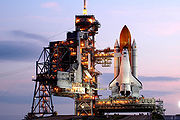
Vehicle Assembly Building
The Vehicle Assembly Building, or VAB, at NASA's Kennedy Space Center was used to assemble and house American manned launch vehicles from 1968-2011. It is the fourth largest building in the world by volume...
on 2 July 2007. On 10 July 2007, Endeavour moved from the Vehicle Assembly Building to Launch Pad 39A. Moving at less than one mile per hour (1.6 kilometre (0.994196378639691 mi)/h) atop the crawler-transporter
Crawler-Transporter
The crawler-transporters are a pair of tracked vehicles used to transport spacecraft from NASA's Vehicle Assembly Building along the Crawlerway to Launch Complex 39. They were originally used to transport the Saturn IB and Saturn V rockets during the Apollo, Skylab and Apollo–Soyuz programs....
, the move began at 20:10 EDT, and was "hard down" (secured in place at the pad) at 03:02 EDT, 11 July 2007.
The crew completed the terminal countdown demonstration test
Terminal countdown demonstration test
A terminal countdown demonstration test is a simulation of the final hours of a launch countdown and serves as a practice exercise in which both the launch team and flight crew rehearse launch day timelines and procedures...
on 19 July 2007, and the Flight Readiness Review meetings were held on 25–26 July 2007, after which NASA managers declared STS-118 a "GO" for launch. The launch was delayed one day to repair a valve in the shuttle's crew cabin pressurization system.
Commander Kelly and the crew arrived at Kennedy Space Center on 3 August 2007, for final launch preparations. The countdown clock began at 20:00 EDT 5 August 2007, for the launch at 18:36 EDT on 8 August 2007.
Wednesday 8 August (Flight day 1, Launch)
.jpg)
Countdown and launch notes:
- The Ice Team members discovered a small crack in the foam surrounding the external fuel tank during their preflight examination. After a review by the Mission Management Team, it was concluded that there was no debris issue regarding the crack, and the tank was safe to fly.
- A problem with the switches associated with the crew hatch required a second and third hatch closure attempt. Hatch closure was completed and verified at 17:23 EDT (21:23 UTC).
- The high-definition video camera used to inspect the shuttle from Kennedy Space Center during launch failed prior to liftoff. The launch team decided that the cameras on the external tank and the orbiter would be sufficient for observations, and went on to launch without it.
- The final forecast predicted 80% go for launch weather.
- Launch Director Mike Leinbach conducted his T-9 poll, and declared Endeavour a "go" for launch at 18:26 EDT (22:26 UTC).
- Liftoff occurred at 18:36:42 pm EDT. (22:36:42 UTC)
- Solid Rocket BoosterSolid rocket boosterSolid rocket boosters or Solid Rocket Motors, SRM, are used to provide thrust in spacecraft launches from the launchpad up to burnout of the SRBs. Many launch vehicles include SRBs, including the Ariane 5, Atlas V , and the NASA Space Shuttle...
s successfully separated at 18:39 pm EDT (22:39 UTC). - Main Engine Cutoff occurred at 18:45:30 pm EDT (22:45:30 UTC)
- External Tank separation occurred at 18:45:45 pm EDT (22:45:45 UTC)
The primary TAL
Space Shuttle abort modes
A Space Shuttle abort was an emergency procedure due to equipment failure on NASA's Space Shuttle, most commonly during ascent. A main engine failure is a typical abort scenario. There are fewer abort options during reentry and descent...
site was Zaragoza Airport
Zaragoza Airport
-Cargo airlines:-Traffic:-External links:* *...
in Spain.
Following the procedures for post-ascent, the crew opened the payload bay doors, activated the Spacehab, powered up the Remote Manipulator System, and performed a variety of other payload activation procedures, before entering their scheduled sleep shift at 04:36 UTC (12:36 am EDT) 9 August 2007.
Thursday 9 August (Flight day 2)
The shuttle crew spent most of the day inspecting the outer hull and the heat shieldSpace shuttle thermal protection system
The Space Shuttle thermal protection system is the barrier that protects the Space Shuttle Orbiter during the searing heat of atmospheric reentry...
. During the mission status briefing, Deputy Shuttle Program Manager (and Mission Management Team chairman) John Shannon reported that during launch, approximately nine pieces of foam were observed breaking off the external fuel tanks. Three of these struck the shuttle. All three strikes are considered to be minor in nature.
Friday 10 August (Flight day 3)
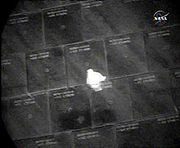
Rendezvous pitch maneuver
The R-bar pitch maneuver , popularly called the rendezvous pitch maneuver, was a maneuver performed by the space shuttle as it rendezvoused with the International Space Station prior to docking. The shuttle performed a backflip that exposed its heat-shield to the crew of the ISS that made...
(RPM), so the ISS
ISS
The ISS is the International Space Station.ISS may also refer to:* I See Stars, an American electronic rock band* ISS A/S, a Danish service company* Idea Star Singer, a Malayalam music reality show by Asianet TV...
crew members could take digital pictures of the heat shield of the orbiter. The images were then analyzed by NASA's Image Analysis Team, as well as the Mission Management Team to inspect the integrity of the orbiter's heat shield. Following a series of leak checks, the hatches were opened at 20:04 UTC (16:04 EDT), and the Expedition 15
Expedition 15
Expedition 15 was the 15th expedition to the International Space Station . Four crew members participated in the expedition, although for most of the expedition's duration only three were on the station at any one time...
crew welcomed the STS-118 crew aboard the station.
After preliminary review of the photos taken by the Expedition 15 crew during the RPM, an area of interest was discovered on the underside of the Shuttle; an area behind the right landing gear door covered with black silica tiles. The tile directly aft of the door had a 3.5 inches (8.9 cm) by 2 inches (5.1 cm) gouge in it. While the tile was penetrated, the underlying felt backing was not. NASA noted in the press conference that launch-time video confirmed a foam strike. This area is less critical than the leading-edge reinforced carbon-carbon
Reinforced carbon-carbon
Carbon fibre-reinforced carbon is a composite material consisting of carbon fibre reinforcement in a matrix of graphite. It was developed for the nose cones of intercontinental ballistic missiles, and is most widely known as the material for the nose cone and wing leading edges of the Space Shuttle...
tiles that were damaged in the Space Shuttle Columbia disaster
Space Shuttle Columbia disaster
The Space Shuttle Columbia disaster occurred on February 1, 2003, when shortly before it was scheduled to conclude its 28th mission, STS-107, the Space Shuttle Columbia disintegrated over Texas and Louisiana during re-entry into the Earth's atmosphere, resulting in the death of all seven crew members...
, but did cause concern for the Mission Management Team. A focused inspection was scheduled for 12 August 2007 to determine whether a patch attempt would be undertaken by the astronauts during an EVA
Extra-vehicular activity
Extra-vehicular activity is work done by an astronaut away from the Earth, and outside of a spacecraft. The term most commonly applies to an EVA made outside a craft orbiting Earth , but also applies to an EVA made on the surface of the Moon...
. NASA once reported that pieces of foam are bound to, and have fallen off of the external tank during the eight and a-half minute ride to orbit
Orbit
In physics, an orbit is the gravitationally curved path of an object around a point in space, for example the orbit of a planet around the center of a star system, such as the Solar System...
. Extraordinarily, an unprecedented three-hundred pieces of foam once struck the underside of an orbiter
Orbiter
An orbiter is a space probe that orbits a planet.-Asteroids:*NEAR Shoemaker...
during launch.
The crew activated the Station-to-Shuttle Power Transfer System (SSPTS) after docking. The SSPTS transfers electrical power from the station to the shuttle, allowing the shuttle to conserve its own power generating resources. An extension of the mission from 11 to 14 days was dependent on proper operation of the SSPTS.
Saturday 11 August (Flight day 4)

Richard Mastracchio
Richard Alan "Rick" Mastracchio is an American engineer and a NASA astronaut. He has flown on three NASA Space Shuttle missions as a mission specialist...
and Dave Williams
Dafydd Williams
Dafydd Rhys "Dave" Williams is a Canadian physician and a retired CSA astronaut. He had two spaceflights, both of which were Space Shuttle missions. His first spaceflight, STS-90 in 1998, was a 16-day mission aboard Space Shuttle Columbia dedicated to neuroscience research...
started the first EVA of the mission, installing the S5 truss to the station, increasing the total mass of the ISS to 232693 kilograms (513,000.3 lb) (513,000 lb). The EVA duration was 6 hours and 17 minutes, and all objectives were successfully completed.
During the Mission Status press conference, Lead ISS Flight Director
Flight director
The term flight director can refer to any one of the following:* the flight controller of a space flight* the flight director of an aviation navigation system...
Joel Montalbano reported that the SSPTS was working well, and the recommendation to the Mission Management Team will be to extend the mission to the planned 14-day mission.
Mission Management Team chair John Shannon reported after additional analysis, it appeared that a piece of foam came off the external tank in the area of the tank's feed line, and bounced off a nearby strut, resulting in a hit to the orbiter's underside. An almost identical section of foam was lost on STS-115
STS-115
Note:The P3/P4 Truss segment and batteries were so heavy that the crew count was reduced from seven to six.-Crew notes:...
, but did not strike the orbiter. John reported after further review of photos taken on flight day three, they do not feel the damage went all the way through the tile, but focused inspection is still planned for flight day five, and decisions would not be made until more information is obtained. Five specific areas will be inspected during focused inspection, and with the data gathered, thermal testing can be done to determine what actions, if any, need to be taken.
Overall, John Shannon classified the foam loss as a "concern", but only with regards to the history that the specific area has with regards to foam loss in past missions. Shannon reported that analysis would be complete by flight day 7 at the latest.
John Shannon also reported that the possible protruding gap filler noticed on flight day 3, was reviewed further, and was determined to be "shim stock", which will burn off in the upper atmosphere, and poses no issues for re-entry.
Sunday 12 August (Flight day 5)
.jpg)
In the daily mission status briefing, Lead Flight Director Matt Abbott announced the official extension of the mission, that the SSPTS was working as planned, and they were pleased with the data gathered during the focused inspection on Sunday. Mission Management Team Chairman John Shannon confirmed the decision of the Mission Management Team to extend the mission to 14 days, and to add a fourth EVA, was unanimous. He noted that the addition of SSPTS will be a valuable new tool, providing not only extended missions, but also the ability to provide the space station with additional supplies of oxygen, water, and other resources.
Shannon reported on the focused inspection, confirming that good laser data and imagery was obtained, and they resolved several areas of interest, classifying them as of no concern. One area of interest was two adjacent thermal plates on the shuttle's underside that had a gouge that appeared to be deeper than would allow them to rule it out. NASA would use data from the focused inspection to model the area, and do thermal analysis of the area. They will use the data to mimic the damage with sample tiles at Johnson Space Center, and using a variety of testing methods, possible courses of action would then be evaluated. No decision would be made until all data had been received and reviewed.
Shannon did report that following STS-118, NASA will do a thorough review of the history of foam loss from the area of the external tank since STS-114
STS-114
-Original crew:This mission was to carry the Expedition 7 crew to the ISS and bring home the Expedition 6 crew. The original crew was to be:-Mission highlights:...
, analysis and testing would be done, and any speculation as to a future course of action would not be made until all the information was available.
Monday 13 August (Flight day 6)
Rick Mastracchio and Dave Williams completed the mission's second spacewalk, successfully achieving all of the scheduled activities. During the EVA, they removed a new CMG from Endeavours payload bay, and moved it to the Z1 truss, where they removed the failed CMG. After installing the new CMG, they placed the failed CMG on an external stowage platform, where it will remain until it is returned to Earth with mission STS-122STS-122
STS-122 was a NASA Space Shuttle mission to the International Space Station , flown by the Space Shuttle Atlantis. STS-122 marked the 24th shuttle mission to the ISS, and the 121st space shuttle flight since STS-1....
. After initial testing on the ground, NASA reported the new CMG was functioning normally.
During the EVA, Mastracchio reported an EVA suit alarm, indicating high levels of
Carbon dioxide
Carbon dioxide is a naturally occurring chemical compound composed of two oxygen atoms covalently bonded to a single carbon atom...
, but after reviewing all indicators and sensors, NASA confirmed it was an instrumentation issue, and the suit itself was fine. At the mission status briefing, NASA reported the suit would be used on future spacewalks, and the issue was not of any concern.
During the Mission Management briefing, John Shannon discussed Endeavor's heat shield and re-entry issues. He reported that after initial modeling they believe the majority of heating will be on the backside of the gouge, and not into the filler bar side, which was the preferable situation. He reiterated that it was a complicated aerodynamic shape, and they wanted to be sure the flow would concentrate in the back "well" of the hole. The engineers and analysts would continue to do additional flow modeling, after which they would take the data into the arc jet testing facility for additional analysis. The first preliminary arc jet tests would be performed Monday night.
Shannon reported a "team four" had been assembled, along with the operations and engineering teams, to assist in data analysis. The teams will look at options for repair if required, and make recommendations to the Mission Management Team after the analysis of tests and data. Shannon stated he had no doubt that if a repair was required, the crew could execute it without significant impact to the mission timeline. He reiterated that this was not a catastrophic damage situation, but simply a situation that they would prefer to fix if possible, similar to the OMS blanket issue during STS-117 in June 2007.
There are three different on-orbit repair techniques available to the crew. Both post-Columbia Return to Flight missions experimented with various repair materials and techniques, and the STS-118 crew has trained for those procedures.
Tuesday 14 August (Flight day 7)
The Endeavour crew awoke on Tuesday to the voices of Tracy Caldwell's family singing happy birthday to her. The two crews successfully removed the ESP-3 from Endeavours payload bay, and installed it onto the P3 truss. They also continued with transfer activities, and several crew members took time out to have two Public Affairs events, one of them answering children's questions from the Discovery Center in Boise, IdahoBoise, Idaho
Boise is the capital and most populous city of the U.S. state of Idaho, as well as the county seat of Ada County. Located on the Boise River, it anchors the Boise City-Nampa metropolitan area and is the largest city between Salt Lake City, Utah and Portland, Oregon.As of the 2010 Census Bureau,...
. During an interview with CBS, Commander Kelly stated that he was not concerned about the tile damage, and would be comfortable with any decision NASA made, "My understanding is this tile damage is not an issue of the safety of the crew... I'm not concerned with our safety." The main reason for fixing it, he noted, would be to assist with processing once the orbiter was back at the Kennedy Space Center.
During the Mission Management Team briefing, Kirk Shireman, Deputy International Space Station
Program Manager, reported that the External Stowage Platform installation went well; the new CMG was working well, and handover of attitude control directly from the shuttle to the station was completed without problems. In addition, a new Russian computer was installed on the station, and testing of the system would be performed in late August. He also mentioned several of the experiments that were launched with STS-118, and reported all experiments were proceeding well. Shireman also noted that as of 15:17 UTC, the Zarya
Zarya
Zarya , also known as the Functional Cargo Block or FGB , was the first module of the International Space Station to be launched. The FGB provided electrical power, storage, propulsion, and guidance to the ISS during the initial stage of assembly...
module of the station had orbited the Earth 50,000 times.
John Shannon reported that the orbiter systems were in excellent shape, and had no issues. With regards to the remaining area of tile damage on the underside of the orbiter, Shannon reported that initial thermal analysis had been completed. Computational fluid dynamics testing at Ames Research Center had been done, and the preliminary results were "cautiously optimistic". Testing at the arc jet facility would continue Tuesday night. Shannon stated they would go through complete EVA scenario testing at the Neutral Buoyancy Lab, to help develop the EVA procedures if needed.
Wednesday 15 August (Flight day 8)
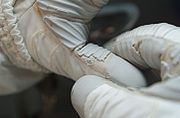
During the Mission Management Team briefing, Joel Montalbano reported that the issue with Mastracchio's suit was never a danger to the suit integrity, and the decision to cut the EVA short was one of precaution. Extended photography was performed, and additional analysis will be completed prior to the fourth EVA. Montalbano reported that the fourth EVA would be no earlier than 18 August 2007.
Lead spacewalk officer Paul Boehm agreed that the EVA went well, the major objectives were completed, and he reiterated that at no time was Mastracchio's suit in any danger of leaking.
EVA Office Manager Steve Doering reported on the details regarding the issue with Mastracchio's glove. The EVA inspection procedure was implemented following STS-116, when a cut was found on Robert Curbeam
Robert Curbeam
Robert Lee Curbeam, Jr. is a former American astronaut, and Captain in the United States Navy.Curbeam graduated from Woodlawn High School, Baltimore County, Maryland in 1980...
's glove following an EVA. The EVA suit comprises five layers of material, and the second layer, called vectran
Vectran
Vectran is a manufactured fibre, spun from a liquid crystal polymer created by Celanese Acetate LLC and now manufactured by Kuraray Co., Ltd. Chemically it is an aromatic polyester produced by the polycondensation of 4-hydroxybenzoic acid and 6-hydroxynaphthalene-2-carboxylic acid.- Properties...
, is a high strength material resistant to tearing. Mastracchio's tear was into the vectran layer. Prior to the next EVA, video analysis will be done of the path Mastracchio took during the spacewalk in an attempt to discover where the tear may have occurred. An analysis of Mastracchio's glove during the previous two EVAs will also be performed.
John Shannon reported that no decision had been made regarding the tile damage on the underside of the orbiter, but the fourth EVA was postponed to at least 18 August 2007. The management team would continue to analyze the potential risks of repair to the underside of the orbiter, as well as any other areas of risk. Shannon reported the results of the arc jet testing showed some erosion into the backside of the adjacent tile upon re-entry, but the erosion did not go through the entire layer of the tile. Preliminary results were encouraging, but additional testing would be performed on Wednesday night. Shannon reported that the final decision would most likely be made on Thursday. Shannon said "I am cautiously optimistic that repairs will not be needed".
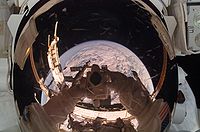
Thursday 16 August (Flight day 9)
The station and shuttle crews continued transfer activities on flight day 9, as well as EVA preparations, which included TPSSpace Shuttle thermal protection system
The Space Shuttle thermal protection system is the barrier that protects the Space Shuttle Orbiter during the searing heat of atmospheric reentry...
repair procedure review, in case NASA decided a repair was necessary.
Mission Specialists Barbara Morgan and Alvin Drew participated in an education event in the morning with students at the Challenger Center for Space Science Education
Challenger Center for Space Science Education
' is a nonprofit educational organization with its headquarters in Alexandria, Virginia, and an international network of Challenger Learning Centers. The organization was founded in April 1986 by the families of the astronauts who died in the Space Shuttle Challenger disaster on January 28,...
in Alexandria, Virginia
Virginia
The Commonwealth of Virginia , is a U.S. state on the Atlantic Coast of the Southern United States. Virginia is nicknamed the "Old Dominion" and sometimes the "Mother of Presidents" after the eight U.S. presidents born there...
. The event was hosted by Dr. June Scobee Rogers, wife of Challengers commander, Dick Scobee
Dick Scobee
Francis Richard "Dick" Scobee was an American astronaut. He was killed commanding the Space Shuttle Challenger, which suffered catastrophic booster failure during launch of the STS-51-L mission.-Early life:...
, and Founding Chairman of the Challenger Center. Morgan and Drew also spoke to reporters from the Associated Press, Reuters and Idaho Public Television.
During the interview with Reuters, Drew stated "We've been talking to the engineers who have been analyzing this far more than we have in space, and they seem to feel that the biggest danger is more to just being able to re-use Endeavour once it gets back on the ground. They seem to be confident, and I trust their confidence that we can get home safely even with the divot that we have in the belly," Morgan added "We have a lot of faith in the program, and we'll do what the engineers decide is the best thing for us to do. We have all confidence we're going to be able to do the right thing."
At 01:00 UTC, 17 August 2007, CAPCOM Shane Kimbrough notified commander Kelly that the Mission Management Team decided that no repair to the damaged tile on the underside of the orbiter would be required.
During the Mission Management Team briefing, John Shannon announced the team's unanimous decision that an EVA to repair the damaged tile was not required, and the tile damage on the underside of the orbiter was not a threat to crew safety. However, the spacewalk to repair the damage could pose a variety of risks, and those risks weighed heavily into the final decision. He noted the arc jet tests actually showed a higher degree of damage than the orbiter would sustain during re-entry, so the tests were helpful in showing the worst "possible" damage, and still did not damage the tile during testing enough to warrant repair.
Shannon did note that the JSC Engineering Independent Group advised NASA managers that repairing the damage on-orbit could assist with mission turn-around time once the orbiter was on the ground. Shannon noted that the risks associated with in-flight repair outweighed the possible delay in processing the orbiter following the mission. He stated that normal turn-around time would not be compromised, as most orbiters have at least 60 tiles replaced after each mission, so the situation would not be any different than past missions.
When pressed during the briefing by a reporter as to the chance of shuttle or crew loss, Shannon reported "I am 100 percent comfortable that the work that has been done, has accurately characterized the damage, and that we will have a very successful re-entry". He stated that over 200 people were involved in the decision, representing over 30 organizations, including NASA Ames Research Center
NASA Ames Research Center
The Ames Research Center , is one of the United States of America's National Aeronautics and Space Administration 10 major field centers.The centre is located in Moffett Field in California's Silicon Valley, near the high-tech companies, entrepreneurial ventures, universities, and other...
, NASA's Langley Research Center
Langley Research Center
Langley Research Center is the oldest of NASA's field centers, located in Hampton, Virginia, United States. It directly borders Poquoson, Virginia and Langley Air Force Base...
, Jet Propulsion Laboratory
Jet Propulsion Laboratory
Jet Propulsion Laboratory is a federally funded research and development center and NASA field center located in the San Gabriel Valley area of Los Angeles County, California, United States. The facility is headquartered in the city of Pasadena on the border of La Cañada Flintridge and Pasadena...
, KSC, JSC
Lyndon B. Johnson Space Center
The Lyndon B. Johnson Space Center is the National Aeronautics and Space Administration's center for human spaceflight training, research and flight control. The center consists of a complex of 100 buildings constructed on 1,620 acres in Houston, Texas, USA...
, and that all the groups combined came to the same decision.
Shannon reported that the glove issue encountered during EVA three had been discussed, and stated that analysis would be continued, in advance of EVA four on Saturday. The crew does have a spare set of gloves, if needed.
Shannon reported on a micro-meteoroid debris strike discovered on the commander's window of the orbiter, which was 1 millimeter in depth. Shannon noted that it was consistent with previous damage sustained on past missions. Analysis would be conducted regarding this issue, using photographs sent down by the crew early Thursday morning.
The final item discussed was Hurricane Dean, which was heading towards the Caribbean Sea, and projected to move into the Gulf of Mexico
Gulf of Mexico
The Gulf of Mexico is a partially landlocked ocean basin largely surrounded by the North American continent and the island of Cuba. It is bounded on the northeast, north and northwest by the Gulf Coast of the United States, on the southwest and south by Mexico, and on the southeast by Cuba. In...
. Contingency procedures and plans were in place, but Shannon did not anticipate it would affect the mission's timeline at all.
Friday 17 August (Flight day 10)
The station and shuttle crews had a relatively quiet day on flight day 10, continuing transfer operations, and doing some troubleshooting on a communication system between the shuttle and station. The two crews took some time out to have a joint news conference with US and Canadian news agencies, and took the official combined crew portrait. When asked by reporters on the ground whether the crew agreed with NASA's decision to return without repairing the damage to Endeavours underside, Commander Kelly replied, "We agree absolutely 100 percent with the decision to not repair the damage."During the mission status briefing, Lead Flight Director Matt Abbott discussed the ongoing preparations and plans with regards to Hurricane Dean, and reported NASA was watching the storm's track closely. If required, contingency plans are available. While the mission's timeline could be changed if required, no decision was made, and the mission was proceeding as planned.
Deputy ISS Program Manager Kirk Shireman reported the S-Band system relocated during the third EVA was working well, and the SSPTS provided enough oxygen to be able to completely fill all reserves on the station. Shireman commented that transfer operations were approximately 75% complete.
EVA Office Manager Steve Doering reported on the decision to proceed with Saturday's EVA. The team analyzed the video downlinked from the third EVA, and the review showed no evidence of any specific event that would indicate a sharp edge, or excessive wear. A review of the manufacturing of the gloves was done, and no concerns were identified. The paths taken by astronauts during spacewalks were reviewed, identifying common paths between the third EVA, and Saturday's planned EVA, and the crew was notified of the common locations, to identify areas where additional glove inspections would be performed on Saturday. Overall, the final EVA would be less "hand-intensive" than the previous spacewalks, and the conclusion following the analysis was that Saturday's EVA would go ahead as planned.
Saturday 18 August (Flight day 11)
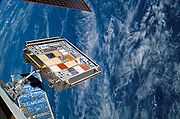
Hurricane Dean
The name Dean was used for five tropical cyclones in the Northern Atlantic Ocean:*1983's Tropical Storm Dean, which struck the coast of Virginia, causing minor erosion and flooding...
's continued path into the Gulf of Mexico. The EVA duration was five hours and 2 minutes, with a total EVA time of 23 hours and 15 minutes for the mission. The EVA accomplished three primary objectives, and one get-ahead task. Two tasks were deferred: plans to tie down debris shields on the Destiny lab, and relocation of a tool box. During the spacewalk, Williams and Anderson got a good look at Hurricane Dean, and were both awed at the sight. "Holy smoke" was Anderon's initial comment. "Man, that's impressive", Williams replied. Anderson added "They're only impressive when they're not coming towards you." Transfer activities were completed ahead of schedule, and both crews worked hard to get everything transferred back to Endeavour after the spacewalk.
Dave Williams set two records during his third EVA; He is the Canadian with the most spacewalks (3); and he passed Canadian Astronaut Chris Hadfield
Chris Hadfield
Chris Austin "Chris" Hadfield, O.Ont, MSC, CD is a Canadian astronaut from the Canadian Space Agency who was the first Canadian to walk in space. Hadfield has flown two space shuttle missions, STS-74 in 1995 and STS-100 in 2001. He has served as CAPCOM for both Space Shuttle and International...
in total EVA time. Williams ended Saturday's EVA with a total of 17 hours, 47 minutes of extravehicular time.

LeRoy E. Cain
Leroy E. Cain is a NASA engineer. Formerly a flight director, he became the manager of Space Shuttle Launch Integration at Kennedy Space Center in November 2005....
reported that the Mission Management Team decided to take extra precautions in preparation for the storm, and STS-118 would be cut short a day. In the event of a hurricane evacuation in Houston, an emergency command center would need to be set up. While it was a contingency set in place for years, NASA would prefer to avoid that situation. To that end, Cain reported the EVA was shortened, and the hatch closure would be done Saturday evening, rather than Sunday as planned. Undocking would be at 11:57 UTC Sunday, with the first KSC Landing opportunity on 21 August 2007.
At 19:46, a short farewell ceremony was performed, followed by hatch closure at 20:10 UTC. Tuesday's tentative KSC landing time would be 12:32 pm EST. (16:30 UTC)
Sunday 19 August (Flight day 12)
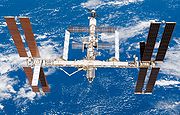
After undocking, two 4-second firings of the Reaction Control System
Reaction control system
A reaction control system is a subsystem of a spacecraft whose purpose is attitude control and steering by the use of thrusters. An RCS system is capable of providing small amounts of thrust in any desired direction or combination of directions. An RCS is also capable of providing torque to allow...
were performed, in order to distance Endeavour from the station and move to a position above it. There, the crew deployed the robotic arm
Orbiter Boom Sensor System
The Orbiter Boom Sensor System is a 50-foot boom carried on board NASA's Space Shuttles. The boom can be grappled by the Canadarm and serves as an extension of the arm, doubling its length to a combined total of 100 feet...
, beginning Late Inspection of the reinforced carbon-carbon tiles on the nose cap and wing leading edges.
At the mission status briefing, Matt Abbott reported the undocking was "flawless", and the late inspection was completed successfully. Monday would be a standard pre-landing day, with checkout of the various systems on Endeavour, as well as an educational media event. Entry Flight Director Steve Stich and the entry team will take over mission duties tonight, in preparation for Tuesday's landing.
John Shannon reported the mission management team meeting went well. The landing plan was reviewed, and all teams reported "go" for landing on Tuesday. The latest track for Hurricane Dean was favorable for the Houston area; the storm seemed to be swinging farther south than originally expected. NASA managers were optimistic that contingency plans would not be needed. Final decisions regarding alternate plans would not be made until Monday, but Shannon noted that White Sands Space Harbor landing facility would be removed as an alternate site. Edwards Air Force Base
Edwards Air Force Base
Edwards Air Force Base is a United States Air Force base located on the border of Kern County, Los Angeles County, and San Bernardino County, California, in the Antelope Valley. It is southwest of the central business district of North Edwards, California and due east of Rosamond.It is named in...
, and Kennedy Shuttle Landing Facility would be the two sites evaluated on Monday.
Monday 20 August (Flight day 13)
On Monday, with the shuttle approximately 68 miles (109.4 km) behind the International Space Station, the crew of Endeavour performed a variety of check-out tests in preparation for entry, configured the Spacehab module for entry, and did some last minute stowage. Kelly and Hobaugh worked with the shuttle landing simulator on board, practicing the anticipated landing tracks. Kelly, Williams and Morgan took some time out to talk to students at the Canadian school, La Ronge, in Saskatchewan.During the mission status briefing, Entry Flight Director Steve Stich reported the track of Hurricane Dean would not require the activation of contingency plans, and the forecast looked favorable for a Tuesday landing at Kennedy Shuttle Landing Facility. There were also two opportunities for a Florida landing, with the first opportunity beginning with a deorbit burn at 15:25 UTC, and landing at 16:32 UTC. The second opportunity would call for a deorbit burn at 17:00 UTC, with landing at 18:16 UTC. Weather was not expected to interfere with landing, with a forecast of high clouds, but no inclement weather. If the second landing opportunity was taken, the shuttle would fly directly over Hurricane Dean, although it would be well above any effects of the storm. NASA did plan to call up Edwards Air Force Base as the backup site, which had two opportunities on Tuesday, but the plan was to attempt a KSC landing, and if both opportunities were waved off, NASA would decide whether to wait a day, and try for a Wednesday landing at KSC. If Wednesday opportunities at Florida were waved off due to weather, a landing at Edwards Air Force Base would be attempted.
Tuesday 21 August (Flight day 14, Landing)
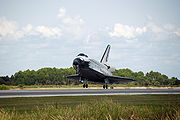
Hypotension
In physiology and medicine, hypotension is abnormally low blood pressure, especially in the arteries of the systemic circulation. It is best understood as a physiologic state, rather than a disease. It is often associated with shock, though not necessarily indicative of it. Hypotension is the...
after landing. At 12:30 UTC, the Space Flight Meteorology
Meteorology
Meteorology is the interdisciplinary scientific study of the atmosphere. Studies in the field stretch back millennia, though significant progress in meteorology did not occur until the 18th century. The 19th century saw breakthroughs occur after observing networks developed across several countries...
Group reported to Entry Team Flight Director Steve Stich that the weather forecast was a "go". The weather at Kennedy Space Center showed only scattered showers moving away from the landing facility, and cross winds were not expected to be a problem. At 15:08 UTC, the crew was given a "go" for the deorbit burn, and the auxiliary power units were started at 15:20 UTC. The 4 minute engine burn was successfully completed at 15:28 UTC, slowing Endeavour by approximately 252 miles per hour, (405 kilometres (251.7 mi)/h) and adjusting the orbiter's trajectory correctly for landing.
Radar acquisition of Endeavour through MILA
Merritt Island spaceflight tracking and data network station
The Merritt Island Spaceflight Tracking and Data Network station, known in NASA parlance as MILA, was a radio communications and spacecraft tracking complex located on at the Kennedy Space Center in Florida...
happened at 16:19 UTC. At 16:20 UTC, the shuttle had passed the area of peak heating, with no issues reported on board. Main landing gear touchdown occurred at 16:32:16 UTC with nose gear touchdown at 16:32:29 UTC. The orbiter came to a complete stop at 16:33:20 UTC. Upon wheel stop, CAPCOM Christopher Ferguson
Christopher Ferguson
Christopher J. Ferguson is a United States Navy captain and a NASA astronaut. He was the pilot of Space Shuttle Atlantis on his first mission to space, STS-115, which launched on September 9, 2006 and returned to Earth on September 21, 2006...
told the crew, "Congratulations, you've given a new meaning to the term 'higher education.'"
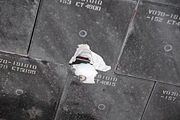
AstroVan
The Crew Transport Vehicle, also known as the Astrovan, is a NASA vehicle used at the Kennedy Space Center to transport astronauts from the Operations and Checkout Building to the launch pad before a launch mission, to the pad for launch dress rehearsals, and back to Operations and Checkout...
.
During the post-landing briefing, NASA Administrator Michael D. Griffin reported that the International Space Station was approximately 60% completed following STS-118. Griffin also stressed the importance of space exploration, and added that the damaged tile on the underside of the orbiter did very well during re-entry.
Associate Administrator for Spaceflight Operations William H. Gerstenmaier
William H. Gerstenmaier
William H. Gerstenmaier has been the Associate Administrator for Space Operations for NASA since 2005. Prior to being Associate Administrator, Gerstenmaier served as the International Space Station Office Program Manager, at Johnson Space Center, a position he began in June 2002.-Early...
reported the damage was actually less than what the arc jet testing produced, a situation that NASA anticipated, and managers had earlier stressed that arc jets show "worst possible" damage. Launch and Entry Flight Director Mike Leinbach stressed how pleased he was with the mission, and with the condition of the vehicle following re-entry. He stated it was "one of the cleanest vehicles the managers have seen since the Return to Flight policies were implemented, if not the cleanest."
At the end of the briefing, Griffin commented to the media who focused on Barbara Morgan being the first "teacher in space", that Morgan was not technically a "teacher in space", nor was she an "Educator Astronaut". He stated she was accepted as a Mission Specialist, before the new class of Mission Specialist Educators were selected in 2004, and NASA considers her to be a mission specialist, who was once a teacher. However, NASA does refer to Morgan as a Mission Specialist Educator in a number of interviews, so the terms seem to be interchangeable to most, if not to Griffin.
During the post-landing crew press conference, Kelly was asked "Did the tile damage enter your mind at all during re-entry, and what did you think about it once you got a look during the walkaround?" Kelly's reply was, "I thought about it, but only because I knew I'd be asked about it. I didn't worry about it at all. I was underwhelmed by it."
Extra-vehicular activity
| EVA | Spacewalkers | Start (UTC Coordinated Universal Time Coordinated Universal Time is the primary time standard by which the world regulates clocks and time. It is one of several closely related successors to Greenwich Mean Time. Computer servers, online services and other entities that rely on having a universally accepted time use UTC for that purpose... ) |
End | Duration | Mission |
|---|---|---|---|---|---|
| EVA 1 | Rick Mastracchio Richard Mastracchio Richard Alan "Rick" Mastracchio is an American engineer and a NASA astronaut. He has flown on three NASA Space Shuttle missions as a mission specialist... Dave Williams Dafydd Williams Dafydd Rhys "Dave" Williams is a Canadian physician and a retired CSA astronaut. He had two spaceflights, both of which were Space Shuttle missions. His first spaceflight, STS-90 in 1998, was a 16-day mission aboard Space Shuttle Columbia dedicated to neuroscience research... |
11 August 2007 16:28 UTC | 11 August 2007 22:45 UTC | 6 hours, 17 minutes | S5 Installation, P6 Radiator retraction and cinch. |
| EVA 2 | Rick Mastracchio Dave Williams |
13 August 2007 15:32 UTC | 13 August 2007 22:00 UTC | 6 hours, 28 minutes | Failed CMG removal; new CMG installation. |
| EVA 3 | Rick Mastracchio Clayton Anderson Clayton Anderson Clayton Conrad Anderson is an American engineer and a NASA astronaut. Launched on STS-117, he replaced Sunita Williams on June 10, 2007 as a member of the ISS Expedition 15 crew.-Education:... |
15 August 2007 14:37 UTC | 15 August 2007 20:05 UTC | 5 hours, 28 minutes | S-Band Antenna Structural Assembly (SASA) relocation from P6 to P1, installation of S-Band Baseband Signal Processor and Transponder to P1, CETA Cart relocation and P6 Transponder retrieval. |
| EVA 4 | Dave Williams Clayton Anderson |
18 August 2007 14:17 UTC | 18 August 2007 19:19 UTC | 5 hours, 2 minutes | OBSS Boom Stand Installation; Retrieval of the MISSE Materials International Space Station Experiment The Materials International Space Station Experiment , is a series of experiments mounted externally on the International Space Station that investigates the effects of long-term exposure of materials to the harsh space environment.... -3 and 4 experiments; EWIS Antenna Installation; Secured Z1 SASA gimbal locks in preparation for down mass on 10A. |
Wake-up calls
NASA began a tradition of playing music to astronauts during the Gemini program, which was first used to wake up a flight crew during Apollo 15Apollo 15
Apollo 15 was the ninth manned mission in the American Apollo space program, the fourth to land on the Moon and the eighth successful manned mission. It was the first of what were termed "J missions", long duration stays on the Moon with a greater focus on science than had been possible on previous...
. Each track is specially chosen, often by their family, and usually has special meaning to an individual member of the crew, or is applicable to their daily activities.
- Day 2: "Where My Heart Will Take Me" by Russell WatsonRussell WatsonRussell Watson is an English tenor who has released singles and albums of both operatic-style and pop songs. The self-styled "People's Tenor" had been singing since he was a child, and became known after performing at a working men's club...
: played for Rick Mastracchio (theme song of the Star Trek: EnterpriseStar Trek: EnterpriseStar Trek: Enterprise is a science fiction television series. It follows the adventures of humanity's first warp 5 starship, the Enterprise, ten years before the United Federation of Planets shown in previous Star Trek series was formed.Enterprise premiered on September 26, 2001...
series). wav mp3 - Day 3: "Mr. Blue SkyMr. Blue Sky"Mr. Blue Sky" is a song by English rock group Electric Light Orchestra, featured on the band's seventh studio album Out of the Blue . Written and produced by frontman Jeff Lynne, the song forms the fourth and final track of the "Concerto for a Rainy Day" suite, on side three of the original double...
" by Electric Light OrchestraElectric Light OrchestraElectric Light Orchestra were a British rock group from Birmingham who released eleven studio albums between 1971 and 1986 and another album in 2001. ELO were formed to accommodate Roy Wood and Jeff Lynne's desire to create modern rock and pop songs with classical overtones...
: played for Scott Kelly wav mp3 - Day 4: "GravityGravity (John Mayer song)"Gravity" is a song by American singer-songwriter guitarist John Mayer and is featured on three of his releases: the 2005 live album Try! by the John Mayer Trio, his 2006 studio album Continuum, and his 2008 live album Where the Light Is: John Mayer Live in Los Angeles...
" by John MayerJohn MayerJohn Clayton Mayer is an American pop rock and blues rock musician, singer-songwriter, recording artist, and music producer. Born in Bridgeport, Connecticut and raised in Fairfield, Connecticut, he attended Berklee College of Music in Boston. He moved to Atlanta in 1997, where he refined his...
: played for Charles O. Hobaugh wav mp3 - Day 5: "Up!Up! (song)"Up!" is a song by Canadian singer Shania Twain. It is the title track and second country single from her 2002 album Up!. The song was written by Twain and her then-husband, Mutt Lange. "Up!" was originally released to North American country radio on January 6, 2003. "I'm Not in the Mood !" was to...
" by Shania TwainShania TwainShania Twain, OC is a Canadian country pop singer-songwriter. Her album The Woman in Me , brought her fame and her 1997 album Come On Over, became the best-selling album of all time by a female musician in any genre, and the best-selling country album of all time. It has sold over 40 million...
: played for Dave Williams. wav mp3 - Day 6: "Outa-Space" by Billy PrestonBilly PrestonWilliam Everett "Billy" Preston was a musician who gained notoriety and fame, first as a session musician for the likes of Sam Cooke, Ray Charles and The Beatles, and later finding fame as a solo artist with hits such as "Space Race", "Will It Go Round in Circles" and "Nothing from...
: played for Alvin Drew wav mp3 - Day 7: "Happy Birthday to YouHappy Birthday to You"Happy Birthday to You", also known more simply as "Happy Birthday", is a song that is traditionally sung to celebrate the anniversary of a person's birth...
" (sung by Tracy's nieces and nephews) played for Tracy Caldwell (it was Caldwell's 38th birthday). wav mp3 - Day 8: "Good Morning World" played for Barbara Morgan and written and performed by her son Adam wav mp3
- Day 9: "Times Like TheseTimes Like These (song)"Times Like These" is the second single released from the Foo Fighters' fourth album One by One. It was released on two main discs in 2003....
" by the Foo FightersFoo FightersFoo Fighters is an American alternative rock band originally formed in 1994 by Nirvana drummer Dave Grohl as a one-man project following the dissolution of his previous band. The band got its name from the UFOs and various aerial phenomena that were reported by Allied aircraft pilots in World War...
: played for Rick Mastracchio wav mp3 - Day 10: "Black Horse and the Cherry TreeBlack Horse and the Cherry Tree"Black Horse and the Cherry Tree" is a song by Scottish singer-songwriter KT Tunstall and is featured on her debut album, Eye to the Telescope. It was released on 21 February 2005 as the lead single from the album, charting at #28 in the UK Singles Chart...
" by KT TunstallKT TunstallKate Victoria "KT" Tunstall is a Scottish singer-songwriter and guitarist from St Andrews, Scotland. She broke into the public eye with a 2004 live solo performance of her song "Black Horse and the Cherry Tree" on Later... with Jools Holland...
: played for Tracy Caldwell wav mp3 - Day 11: "Learn to FlyLearn to FlyFor other results, see Learning to fly."Learn to Fly" is the first single from the Foo Fighters' third album There Is Nothing Left to Lose. It was released on two different singles in the UK in 1999...
" by Foo Fighters: played for Al Drew wav mp3 - Day 12: "Teacher, Teacher" by 38 Special played for Barbara Morgan wavmp3
- Day 13: "Flying" by Long John Baldry TrioLong John BaldryJohn William "Long John" Baldry was an English and Canadian blues singer and a voice actor. He sang with many British musicians, with Rod Stewart and Elton John appearing in bands led by Baldry in the 1960s. He enjoyed pop success in the UK where Let the Heartaches Begin reached No...
played for Dave Williams wavmp3 - Day 14: "Homeward Bound" by Simon and GarfunkelSimon and GarfunkelSimon & Garfunkel are an American duo consisting of singer-songwriter Paul Simon and singer Art Garfunkel. They formed the group Tom & Jerry in 1957 and had their first success with the minor hit "Hey, Schoolgirl". As Simon & Garfunkel, the duo rose to fame in 1965, largely on the strength of the...
played for the entire crew wavmp3
Contingency mission
STS-322STS-3xx
Space Shuttle missions designated STS-3xx were rescue missions which would have been mounted to rescue the crew of a Space Shuttle if their vehicle was damaged and deemed unable to make a successful reentry...
was the designation given to the Contingency Shuttle Crew Support mission which would have been launched in the event Space Shuttle Endeavour
Space Shuttle Endeavour
Space Shuttle Endeavour is one of the retired orbiters of the Space Shuttle program of NASA, the space agency of the United States. Endeavour was the fifth and final spaceworthy NASA space shuttle to be built, constructed as a replacement for Challenger...
had become disabled during STS-118. It would have been a modified version of the STS-120
STS-120
-Crew notes:As commander of STS-120, Pamela Melroy became the second woman to command a space shuttle mission. Additionally, the Expedition 16 crew that received STS-120 was commanded by Peggy Whitson, the first female ISS commander...
mission, which would have involved the launch date being brought forward. If it had been needed, it would have been launched no earlier than 22 September 2007. The crew for this mission would have been a four-person subset of the full STS-120 crew.
Media
See also
- Space Shuttles
- 2007 in spaceflight
- List of ISS spacewalks
- List of space shuttle missions
- List of spacewalks and moonwalks
- List of human spaceflights chronologically

